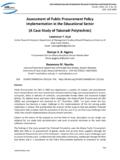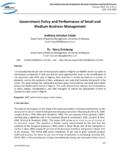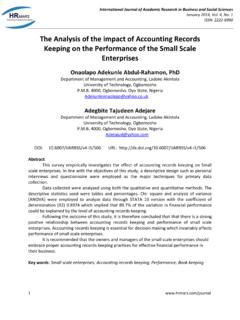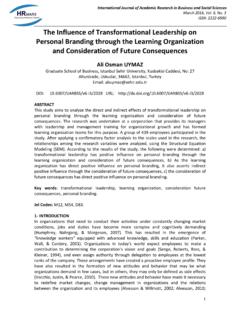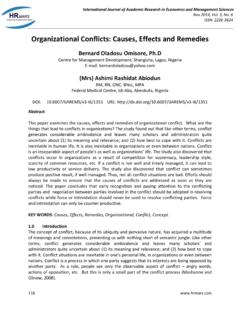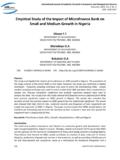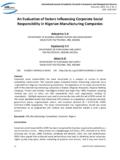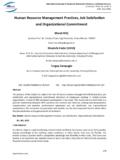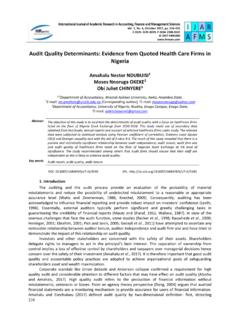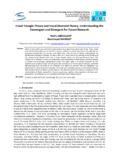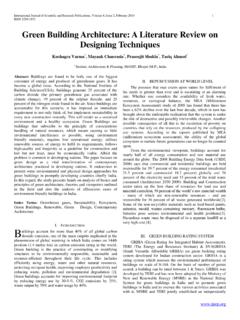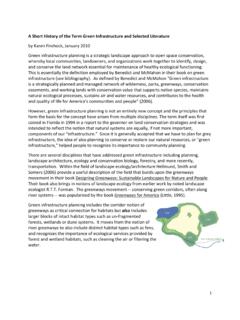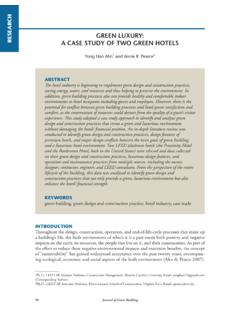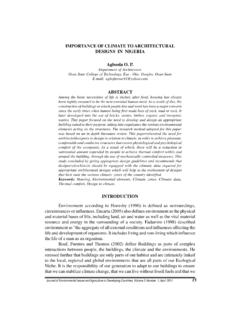Transcription of Critical Success Factor for Sustainable Facilities ...
1 International Journal of Academic Research in Business and Social Sciences Vol. 8 , No. 7, July 2018, E-ISSN: 2 2 22 -6990 2018 HRMARS. Critical Success Factor for Sustainable Facilities Management: A Review of Literature Intan Bayani Zakaria, Siti Zubaidah Hashim, Nadira Ahzahar To Link this Article: DOI: Received: 28 May 2018, Revised: 19 June 2018, Accepted: 29 June 2018. Published Online: 18 July 2018. In-Text Citation: (Zakaria, Hashim, & Ahzahar, 2018). To Cite this Article: Zakaria, I. B., Hashim, S. Z., & Ahzahar, N. (2018). Critical Success Factor for Sustainable Facilities Management: A Review of Literature. International Journal of Academic Research in Business and Social Sciences, 8(7), 469 480. Copyright: 2018 The Author(s).
2 Published by Human Resource Management Academic Research Society ( ). This article is published under the Creative Commons Attribution (CC BY ) license. Anyone may reproduce, distribute, translate and create derivative works of this article (for both commercial and non-commercial purposes), subject to full attribution to the original publication and authors. The full terms of this license may be seen at: Vol. 8, No. 7, July 2018, Pg. 469 - 480. JOURNAL HOMEPAGE. Full Terms & Conditions of access and use can be found at 469. International Journal of Academic Research in Business and Social Sciences Vol. 8 , No. 7, July 2018, E-ISSN: 2 2 22 -6990 2018 HRMARS. Critical Success Factor for Sustainable Facilities Management: A Review of Literature Intan Bayani Zakaria, Siti Zubaidah Hashim, Nadira Ahzahar Faculty of Architecture, Planning and Surveying, Universiti Teknologi MARA (Perak Branch), Malaysia Abstract: Effort to Sustainable Facilities management (SFM) requires a paradigm shift in terms of management, technology adoption and end-user behaviors.
3 In order to achieve the above efforts, the main role that the FM profession can play is by encouraging management hierarchy in the organization and end users to understand the importance and impact of Sustainable development. At the same time, FM professions need to be proactive and be a good role model in managing the Facilities and services of a building. According to previous research, the Sustainable Facilities management process and practices are unclear and immature. Therefore, the objective of this study is to identify and compile Critical Success factors in order to give a positive impact on implementing SFM, as per the literature. The study used content analysis method with frequency analysis. Nineteen Success factors were identified.
4 The most common identified Success factors in the literature are strict legislation set by the government, organization's sustainability policy, the commitment and the perception of practicing Facilities manager, the involvement of senior management personnel and organizations should provide training and practical management tools for Facilities managers. One of the future research can aim towards conducting a severity analysis of the identified factors with regard to the Facilities management industry. Keywords: Sustainable Development, Facilities Management, Sustainable Facilities Management, Critical Success Factor Introduction Sustainable Development According to a report conducted by Brundtland Commission(WCED,1987), Sustainable development is defined as development which meets the needs of the present without compromising the ability of future generations to meet their own needs.
5 Another researcher mentioned that focal point of sustainability is the integration of economic, social and environmental development as the triple bottom line for Sustainable development (Elmualim et al.,2009). Although there are many different definitions, there is a shared theme of environment, future and equality. In consideration of sustainability aspect, it guides us to make improvements to our daily activities, business decisions, 470. International Journal of Academic Research in Business and Social Sciences Vol. 8 , No. 7, July 2018, E-ISSN: 2 2 22 -6990 2018 HRMARS. and future planning by taking into account the contribution of the activity to the economy, the social and the environment. The incorporation of Sustainable development in the day-to-day functions of Facilities management is not new; the business world has also seen that with the adaptation of green sustainability it has added a competitive edge to the global market (Vidler,2011).
6 According to Shah (2007), the primary focus for Facilities managers now is to provide added value as part of the management of their property by identifying environmental costs and business opportunities but in the other hand, it has previously been observed that there is lack of skills, knowledge and tools within the Facilities Management industry to manage Facilities from a sustainability perspective actively (Elmualim, 2012a; Escriva-Escriva, 2011). These problems protrude the basis of this study. Facilities Management The concept of facility management (FM) is a combination of non-core organization services involving mainly the maintenance of buildings. The existence of this facility management is intended to assist and support the core business of an organization.
7 The main factors involved in managing Sustainable Facilities include management, technology applications and end-users. Effective building maintenance methods will contribute to improving building performance. For example, good energy management in the building can reduce carbon dioxide emissions and at the same time preserve the environment (Escriva-Escriva, 2011). Looking at the above this clearly shows that FM plays an essential role in delivering a Sustainable environment as expected by the end user company (Nousiainen and Junnila, 2008). Sustainable Facilities Management (SFM) is Critical because a building is the highest consumer of energy ( Suzuki and Oka, 1998) during operation and involves the generation of waste from indoor activities.
8 FM- related management costs are the second largest operating cost after personnel and asset costs. Therefore, effective FM management can reduce overall cost burden. Sustainable Facilities Management FM has long established and expanded in Japan, Hong Kong, New Zealand, Singapore and South Africa. FM's most significant contribution to the organization is to assist building management in a more efficient direction while directly supporting the core business of the organization (Kamaruzzaman and Zawawi, 2010). According to Shah (2007) in Australia, the FM industry recorded an annual turnover of more than AUD$60 billion which is now a major trending business in the country. For other developing countries such as Malaysia, FM only began to lay the foundations during the second half of the 1990s and now FM development has already started to be given particular focus especially FM in the public sector (Kamaruzzaman and Zawawi, 2010).
9 The effort in sustainability requires a paradigm shift in terms of management, technology adoption and end-user behaviors (Elmualim et al., 2009). In order to achieve the above target, the central role that the FM profession can play is by encouraging management hierarchy in the organization and end users to understand the importance and impact of Sustainable development (Shah, 2007). At the same time, FM professions need to be proactive and be a good role model for managing the Facilities and services in the building. 471. International Journal of Academic Research in Business and Social Sciences Vol. 8 , No. 7, July 2018, E-ISSN: 2 2 22 -6990 2018 HRMARS. In order to make a precise dimension on sustainability in Facilities management, Prof.
10 Antje Junghans had produced a basic structure of Sustainable Facility Management known as SFM-Model ( ). The category includes primary ]processes, space and infrastructure, people and organization. Dimension and target of sustainability are shown in Table 1. Fig. 1. The SFM model (Jughans,2011). Table 1: Dimension and target of sustainability 472. International Journal of Academic Research in Business and Social Sciences Vol. 8 , No. 7, July 2018, E-ISSN: 2 2 22 -6990 2018 HRMARS. Dimensions of sustainability Target Social supply of adequate buildings for work and life;. compliance with health, safety and security requirements. Environment reduction of resources;. usage of recyclable building material; considering the separability of used material for re-use; reduction of energy consumption and usage of renewable energy sources.
